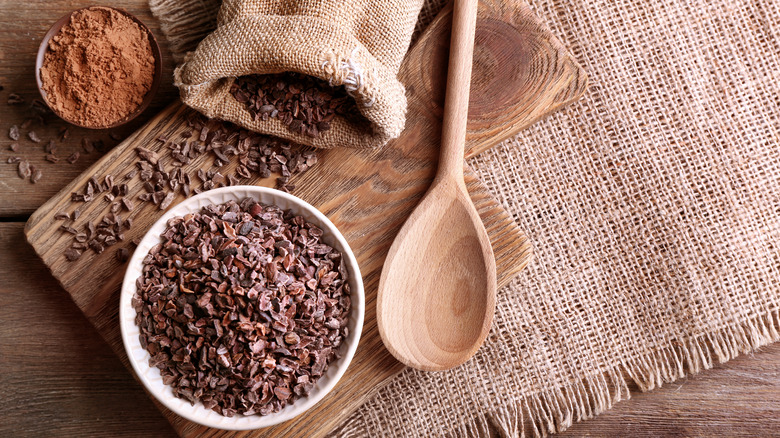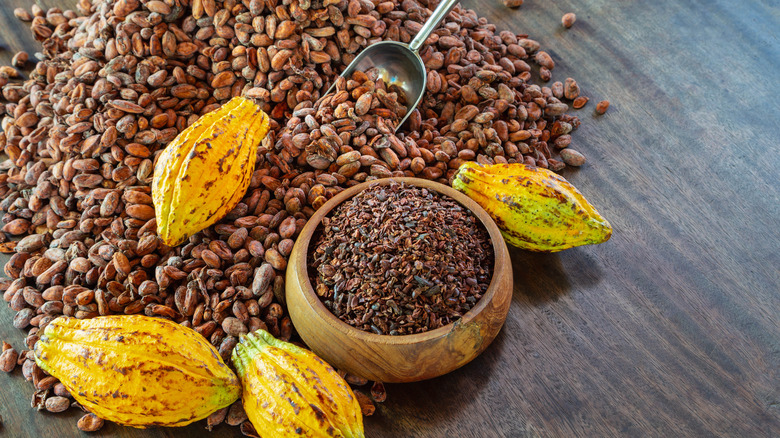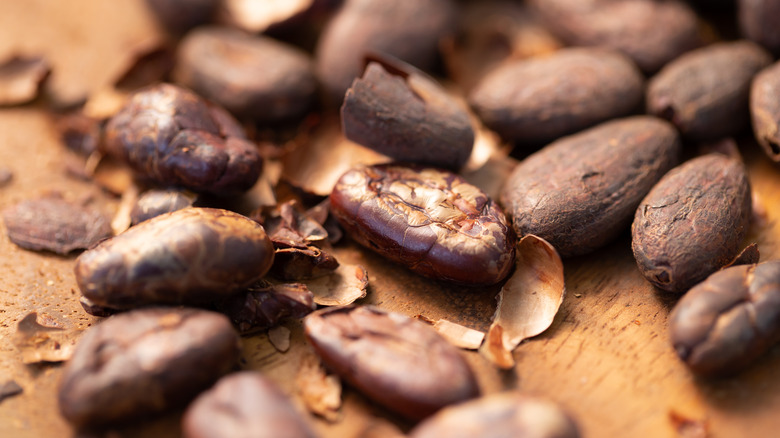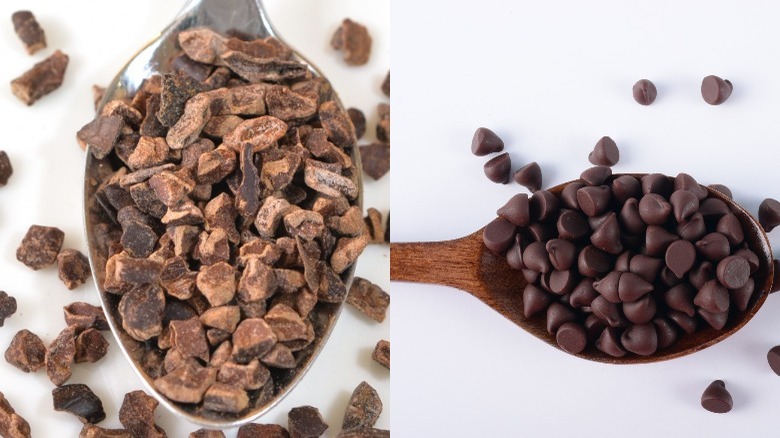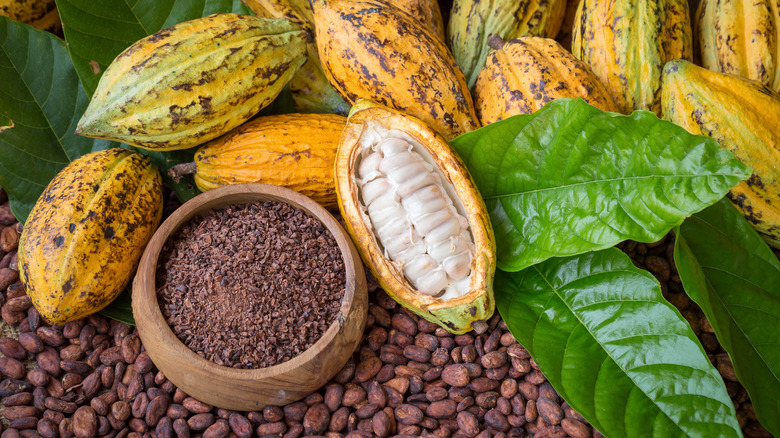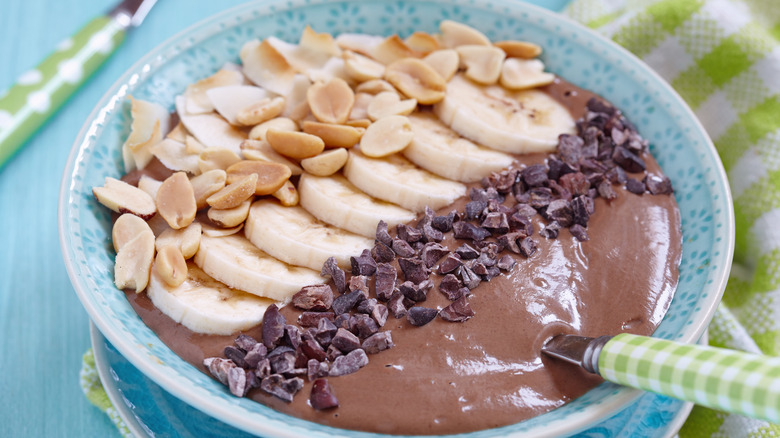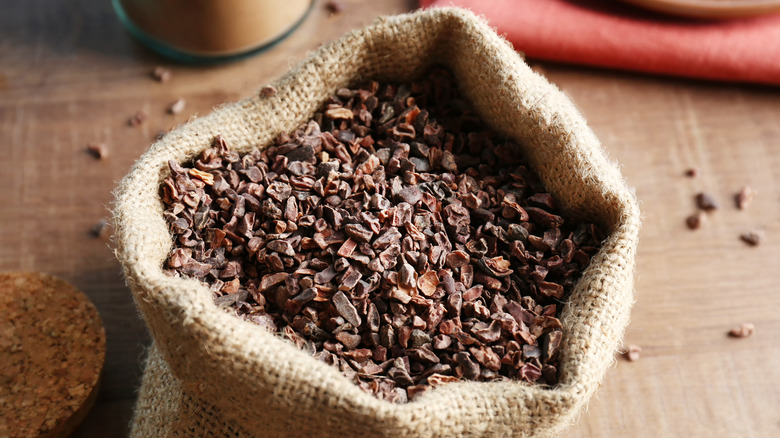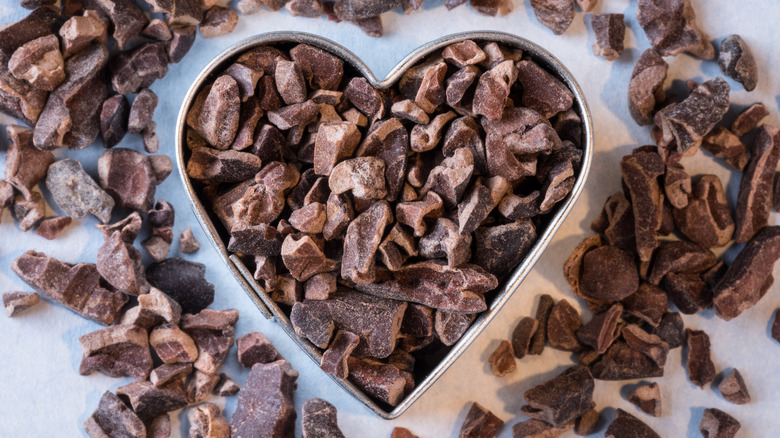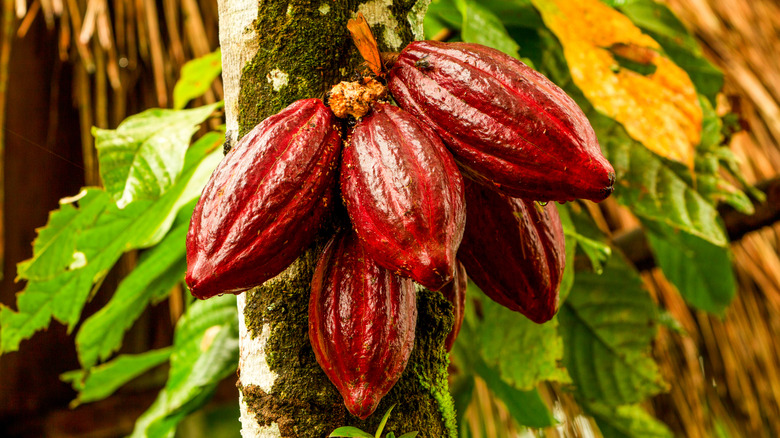What Are Cacao Nibs And Are They Nutritious?
Anything that is related to chocolate deserves plenty of attention, and cacao nibs are no different. Think of them as a precursor to a chocolate bar — less processed and therefore packed with nutritious qualities. Nuts.com even describes them as "nature's chocolate chips” as they are much more "in the raw" than their popular counterparts. While most people are familiar with chocolate chips, cacao nibs are maybe not as common, though they are becoming increasingly available.
Cacao nibs come from the cacao tree, also known as Theobroma cacao, or "food of the gods" in Greek, according to Britannica. If you are confused with the subtle distinction between cocoa and cacao – although they are often used interchangeably, Cacao magazine explains that cacao commonly refers to the plant and beans, whereas cocoa implies some level of processing. The source also notes that the terminology is further confused by the fact that cocoa might just have been an English translation of the Spanish word cacao. So, at the store, you may notice the nibs labeled as both. Here's more about these little morsels of goodness.
What are cacao nibs?
Britannica reports that the cacao plant originated in the Amazon jungle and is now grown in other tropical regions around the world, including West Africa, Central America, and Asia. Chocolate.org points out that the primary countries growing cacao are located in proximity to the equator, since the plant requires lots of humidity to thrive. The source also notes that the Theobroma genus is a member of the extensive Malvaceae family, along with hibiscus, okra, and cotton.
Like those other flowering plants, the cacao tree grows a large oblong fruit, similar in size and shape to a papaya. It has a hard shell that can be red, orange, or yellow, but the real treats are contained inside. Once you cut through the pod's thick exterior, you'll see it's filled with beans covered in a white pulp. The beans are eventually transformed into cacao nibs or chocolate. The white flesh is also sweet and tasty but is often discarded in commercial production to get straight to the beans.
As for cacao nibs, Healthline explains that they are broken pieces of the bean once it has been fermented, dried, roasted, and de-husked. The nibs are dark brown with a texture similar to a coffee bean according to Nuts.com. Since the nibs are essentially crushed pieces of cacao bean, the shape and size aren't especially uniform, but they are close to the size of a black pepper kernel.
How are cacao nibs made?
Since cacao nibs come from the cacao bean, the first part of the process to make them involves separating the beans from the pods. To do so, the fruit is cut open, and the pulp-covered beans are removed from the shell. At this point, The Chocolate Project explains that the beans and the pulp are placed into wooden boxes and covered, allowing the sugars in the pulp to ferment for about a week. Even though the pulp is later separated from the bean, this fermentation process lends flavor and complexity and reduces some of the bitterness, according to Scientific American. The source compares the process to fermenting grapes for wine, since the subtle variations in environment will result in nuanced flavors.
Following the fermentation process, Cacao magazine explains that the beans are then dried (usually in the sun), roasted, shelled, and then crushed to make cacao nibs. Roasting helps to tame the bitter flavors and introduces some nuttiness. However, Healthline notes that not all cacao nibs are roasted — so you can always toast them yourself in a dry pan to soften the bitterness. If you're wondering how chocolate comes to be from this process, Cacao magazine indicates that, to make the sweet stuff, nibs are further ground into a paste along with sugar and sometimes the addition of milk powder.
Cacao nibs vs. chocolate chips
Although cacao nibs and chocolate chips both start out as cacao beans, the level of processing is what makes them distinct. As mentioned, to make cacao nibs, the beans are fermented, dried, roasted, shelled, and crushed. Making chocolate chips takes it a step further as cacao nibs are then ground to a smooth texture that's made up of cacao liquor and cacao butter, according to Simon Fraser University. According to Mental Floss, chocolate chips have a lower cocoa butter content compared to standard chocolate bars. This affects their behavior at high temperatures, allowing them to maintain their shape when baked.
Simon Fraser University notes that depending on the type of chocolate chip, sugar or milk powder may be added to alter the flavor. As well, lecithin is often included to emulsify the chocolate, creating a smooth uniform texture. Lecithin also assists with the structure of chocolate chips, so that baked goods can have distinguishable pieces of chocolate scattered throughout. Some chocolate chip production methods may contain a number of additional ingredients, further distancing the chips from the raw, pure bean. Ultimately, the final liquid product is poured into molds, which can be bar- or chip-sized.
Clearly, chocolate chips involve far more processing compared to cacao nibs. Nevertheless, if you are looking for something to add to your baking that will have a rich, melt-in-your-mouth texture, chocolate chips are a good bet.
What do cacao nibs taste like?
Keeping in mind that cacao nibs are pure cacao beans that have been fermented, dried, roasted, and crushed — and with no additives introduced — suffice to say, you shouldn't expect a taste that's anything similar to a chocolate bar. A fair comparison would be biting into a roasted coffee bean versus enjoying a sweetened cappuccino. While both come from the same original source, the flavor is not the same.
Generally, cacao beans are bitter and display some fruity flavors, which Scientific American explains is a result of the fermentation process. The source notes that compounds are created called esters, which have notably fruity and floral characteristics. Furthermore, bacterial action causes a transformation of some of the molecules in the bean, causing flavors to shift from extremely bitter to nutty. Since the specific bacteria and quantity vary from region to region, a range of flavors can be present.
When cacao nibs are heated, the bitterness is further reduced so you can dry roast them in a pan to enhance the nutty flavors. While some people love the bitter flavors and devour cacao nibs by the spoonful, for many they are an acquired taste. If you want to include them in your diet, try adding them to yogurt, smoothies, or baked goods that already contain some sweetness.
How to cook with cacao nibs
If you just want to get a quick cacao fix, you can always eat the nibs by the spoonful. Since most have already been roasted, they are fine to eat directly from the package. Some may be labeled raw cacao nibs and aren't heated to significantly high temperatures but they're still consumable. To minimize any bitterness, just give them a quick toast in a dry pan.
For those that are less inclined to chew on bitter cacao beans, there are plenty of ways to include them in recipes with complementary flavors. For an easy, crunchy, and nutritious addition to your smoothies, baked goods, trail mix, and oatmeal, Nuts.com recommends mixing in a spoonful of cacao nibs that add flavor and texture. The source also suggests incorporating the crispy bits into baked goods. If you are looking for ways to minimize added sugars but are eager to savor the rich aromas of pure cacao, nibs are a great option.
There's also Healthline's recommendation to blend the nibs into nut butter to add some crunchiness to the smooth texture. Healthline also points out that cacao nibs can be used in savory sauces or as a unique crust for grilled meats.
Where to buy cacao nibs
Cacao nibs aren't as readily available as chocolate bars, but you'll still be able to find them in various places. You could easily purchase them online and have them delivered if you want to obtain some easily. As well, Cacao magazine notes that they can be found in many supermarkets if you check the natural food aisle and bulk food sections — cacao nibs will often be located with other cacao-based baking items.
Cacao magazine also explains that although some packages are labeled as raw cacao nibs, it's not totally the case as the fermenting and roasting steps require temperatures that exceed what would be considered the threshold for raw food. The source recommends choosing cacao nibs that have been produced by small scale artisanal chocolate makers since they tend to prioritize quality and ethical bean sourcing.
Once you get your hands on some tasty cacao nibs, you'll want to store them suitably to keep them fresh. Foods Guy indicates that they should be kept in a sealed container out of light or direct heat. In these conditions, the source reports that cacao nibs can even last for years. Alternatively, you can freeze them if you won't be using them frequently.
Nutritional information about cacao nibs
If you need more reasons to head to the supermarket to buy cacao nibs, you'll be glad to know that they have plenty of nutritious qualities since there are no additives and barely any processing. In particular, cacao beans contain flavonoids that are antioxidants in plants that may be associated with decreased inflammation, lower risk of cancer and heart disease, and an overall boost in brain function (via Healthline).
The outlet also reports that the main minerals contained in cacao are iron and magnesium, with smaller quantities of zinc, copper, phosphorous, and manganese. The source explains that healthy fats and fiber are also found in cacao, which increases satiety. Paired with low levels of sugar, cacao nibs are a satisfying treat to have when you're craving chocolate. A 2017 study demonstrated that regular cacao consumption could diminish certain signs of insulin resistance, too, suggesting that it could assist with blood sugar regulation.
Aside from all of the physical benefits, Bon Appétit explains that cacao contains theobromine, which is reported to have mood and energy boosting effects. On top of that, HuffPost notes that anandamide, a compound referred to as the bliss molecule, is also present in cacao beans. Nonetheless, if you eat large quantities of cacao nibs, you may feel a bit anxious or shaky since cacao contains minor levels of caffeine, too.
Other varieties of cacao
Since cacao nibs are made from cacao beans, they can be of three main varieties — criollo, forastero, and trinitario. Perfect Daily Grind explains that differences in flavor, cost, and production dictate which type of bean is used in any given context. Distinct geographies affect the soil and climate, too, which may influence the overall taste of the chocolate for a number of reasons, including the microbial activity during fermentation (via Scientific American).
The source explains that criollo has a lower yield, which in turn has caused it to be perceived as rarer and of higher quality. Meanwhile, forastero makes up 80% of the present market, which has led to the assumption that it is of lesser caliber. It's said that trinitario isn't as commonly grown, with Willie's Cacao indicating that it is a hybrid of criollo and forastero varieties.
The three varieties have different levels of resistance to disease, which makes them more suitable for certain regions. As for the flavor, Willie's Cacao describes criollo as more flavorful, with a broader set of aromas, including nut, caramel, and fruit. Perfect Daily Grind notes that forastero and trinitario have intense and powerful flavors, and are slightly bitter. Overall, the source reports that criollo tends to be more expensive and used for higher-quality products, whereas forastero is cheaper and less likely to be used to produce pure chocolate bars.
